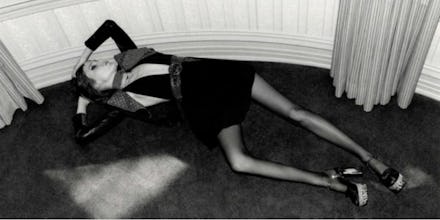This Fashion Ad Just Got Banned for "Unhealthily Underweight" Model

There's going to be one less fashion ad in magazines next month.
High-end fashion label Saint Laurent is no longer permitted to show one of its spring advertisements in the U.K., after the Advertisement Standards Authority ruled the image "irresponsible," for showcasing a model who appears "unhealthily underweight."
The ASA investigated the ad, as they often do, after they received a single complaint from a reader of Elle UK. The complainant charged that the ad was "irresponsible" because it featured a too-thin model, which could promote unhealthy beauty standards.
Which is why, notably, the issue with the ban is not whether the model in the ad, 18-year-old Kiki Willems, is underweight or not. It's the perception that matters. In describing their rationale for the ruling, the ASA wrote:
"[We] considered that the model's pose and the particular lighting effect in the ad drew particular focus to the model's chest, where her rib cage was visible and appeared prominent, and to her legs, where her thighs and knees appeared a similar width, and which looked very thin, particularly in light of her positioning and the contrast between the narrowness of her legs and her platform shoes."
Cracking down on the industry: It's not the first (or second, or third) time a fashion ad has been banned by the ASA, in which the agency rules they "must not appear again in its current form" in the U.K. British fashion brand Drop Dead was called out for featuring a model with "highly visible" hip, rib and collar bones and "hollows in her thighs."
Last year, the ASA ruled a Miu Miu ad unacceptable for showing a sexualized image of a minor, according to i-D. The model in question was in fact 22 years old, but that was beside the point — what mattered was the perception of the model and the message it sent.
The ban of a single image is by no means a comprehensive solution toward remedying fashion's body problem, which is tied up in society's broader beauty standards (models aren't the only thin women we idolize), as well as deep industry traditions (designers use samples of clothing to dress models; a consistent body size across the modeling industry, so any sample can fit any model, is useful).
Sending the wrong message: It is, however, an important step forward in combating images that promote a body ideal that's unattainable for so many women. European countries have slowly begun realizing the immense power and influence that fashion and advertising hold over women's self-perceptions of their bodies. France recently became the latest country to ban models with an unhealthily low body mass index from working in the fashion industry's runways.
France's new laws on the hiring of models hasn't come without plenty of debate. Critics point out that it's a flawed tactic to combat anorexia and can amount to skinny-shaming women who are naturally slender, as skinny doesn't always mean unhealthy.
But critically analyzing the impact that fashion images have on individuals is a crucial piece of addressing the bigger body problems. One by one, bans on ads can prompt more fashion houses to re-examine the values their images are putting forth.